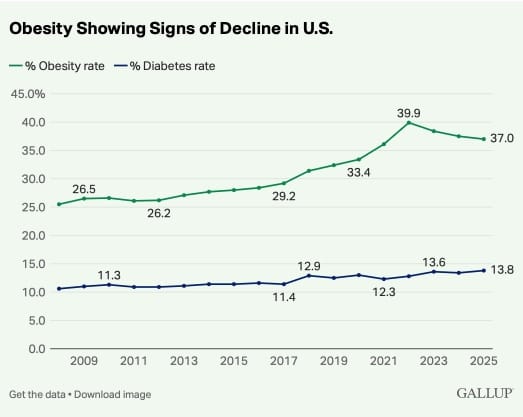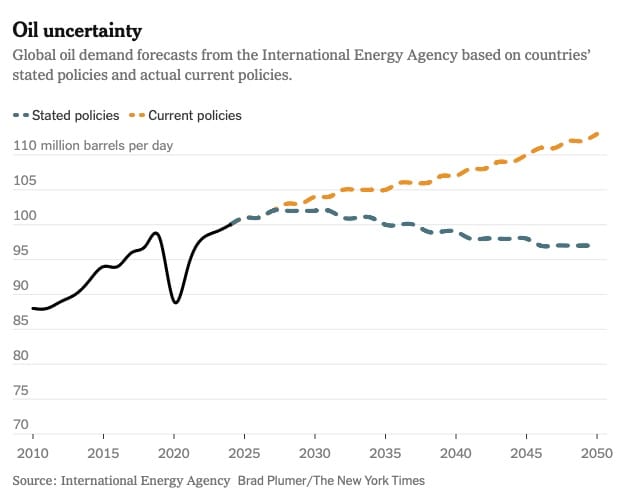Top 5 US news stories
November 12 2025

Schmidt: Use AI to Bolster Democracy, Not Replace It
Obesity Rate Drops as GLP-1 Drug Use Doubles in One Year
Tech Giants' AI Ambitions Drive Complex New Funding Schemes
Energy Agency Softens Forecast on Imminent Peak for Fossil Fuel Demand
Xi Cites Lessons From USSR Collapse as Rationale for Military Purge Amid Nuclear Buildup
…US GOVERNMENT SHUTDOWN ENTERS 43rd DAY AS US WAITS ON HOUSE VOTE TO REOPEN…
1. Schmidt: Use AI to Bolster Democracy, Not Replace It
Albania is the first country to take a real step toward “algocracy”: government by algorithm. In September its prime minister announced that all decisions concerning which private suppliers will provide goods and services to Albania’s government — over $1 billion annually — will be made by an A.I. avatar named Diella. Albania has long suffered from corruption, particularly in this realm. The unbiased, competent, algorithmic Diella is thought to be the solution. It’s a seductive trade: When democratic systems fail, simply replace them with algorithmic ones. But it’s the wrong reflex. Algorithms can optimize efficiency, but they can’t decide between competing values — the very choices that lie at the heart of democratic politics. Without transparency about how Diella reaches its conclusions and without mechanisms to challenge its decisions, citizens will inevitably feel wronged and without recourse. Rather than replace democracy with A.I., we must instead use A.I. to reinvigorate democracy, making it more responsive, more deliberative and more worthy of public trust.
By Eric Schmidt and Andrew Sorota Mr. Schmidt is a former chief executive and chairman of Google. Mr. Sorota is Mr. Schmidt’s head of research.
NYT
2. Obesity Rate Drops as GLP-1 Drug Use Doubles in One Year
WASHINGTON, D.C. — After peaking at a record high of 39.9% in 2022, the U.S. adult obesity rate has gradually declined to 37.0% in 2025. This is a statistically meaningful decrease representing an estimated 7.6 million fewer obese adults compared with three years ago. Over the past year, more Americans have turned to Type 2 antidiabetic GLP-1 drugs such as semaglutide (brand names Ozempic and Wegovy) for weight loss purposes. The percentage of adults who report taking this class of medicine specifically for weight loss has increased to 12.4%, compared with 5.8% in February 2024 when Gallup first measured it. Usage among women (15.2%) continues to outpace men (9.7%), but both groups have more than doubled their use in the past year. These results dovetail with increased awareness of the drugs used for weight loss, which has risen from 80% to 89% nationally in the same period.

Gallup
3. Tech Giants' AI Ambitions Drive Complex New Funding Schemes
Tech giants need so much money for their artificial-intelligence ambitions that Wall Street is developing new ways to get it for them. Details of some of the biggest AI infrastructure deals, including those involving Meta , OpenAI and xAI, are coming into focus, revealing lucrative, innovative—and in some cases risky—funding schemes. Exhibit One is the deal fund manager Blue Owl Capital struck with Meta in their joint venture to build a giant data center in Louisiana called Hyperion. Blue Owl is buying private equity in the deal and is receiving a debt-like guarantee from Meta if the partnership falls apart, an extraordinary protection, according to several people involved. Another deal involving OpenAI and Oracle involves a lending syndicate of more than 30 banks, according to deal materials reviewed by The Wall Street Journal. Tech titans are offering sweeteners in their deals because they need to offload risk as the cost of the AI arms race soars, threatening even the strongest competitors. Meta’s market value dropped by around $300 billion in a few days after Chief Executive Mark Zuckerberg warned about higher spending on AI, spooking shareholders already worried about an AI bubble. Banks and fund managers are writing big checks for now, but many are worried about how the complicated deals being signed today will perform when the AI frenzy calms down. Another concern is that each time tech companies take on lots of new debt, their cost of borrowing rises.
WSJ
4. Energy Agency Softens Forecast on Imminent Peak for Fossil Fuel Demand
The world’s leading energy agency is backing away, sort of, from its view that global demand for fossil fuels could very well peak by the end of the decade. Two years ago, the International Energy Agency caused a stir when it published a widely read analysis suggesting that the world’s use of oil, gas and coal could start to decline by the 2030s because of the energy policies many governments were pursuing. The prospect that fossil fuel demand might soon peak was seen as a potential turning point in efforts to slow climate change. But in a major new report published on Wednesday, the energy agency has a different message about a peak in fossil fuel use: It’s complicated. The agency’s latest World Energy Outlook, a comprehensive report on global energy trends, still includes its previous “stated policies” scenario, essentially projecting that countries will continue enacting policies that help tackle climate change and adopting solar panels, wind turbines and electric vehicles at a rapid clip, potentially leading to a decline or plateau in the use of oil, gas and coal by 2035. Unlike last year, however, the agency is also including a more conservative “current policies” scenario that assumes countries won’t enact any additional energy policies and will face obstacles in shifting to cleaner forms of power. The Trump administration had pressured the agency to include this scenario, which sees oil and gas demand rising steadily through 2050, leading to significantly more global warming.

NYT
5. Xi Cites Lessons From USSR Collapse as Rationale for Military Purge Amid Nuclear Buildup
China’s nuclear forces are expanding quickly. Yet behind that rise, the top leader Xi Jinping’s sweeping purge of generals and military leaders has exposed deep-seated corruption and raised questions about the country’s ability to manage its growing arsenal. The uncertainty adds to concerns about a new era of volatility in global nuclear politics, as President Trump has called for renewed U.S. testing and as Washington is also pushing through major changes in its military. In Beijing, Mr. Xi’s purges in the People’s Liberation Army cut far deeper. He has carried out a cleanup that has shaken the Rocket Force, the branch that oversees China’s nuclear forces and is a crucial part of Mr. Xi’s ambition to build a “world-class military” by 2049. Top commanders have disappeared. Others have been jailed. And defense contractors have been stripped of their party titles and detained for investigation. Mr. Xi’s purges stem from a lesson he has drawn from history: that the Communist Party survives only when the army obeys one leader without question. Early in his rule, Mr. Xi warned that the Soviet Union collapsed because the party lost control of its military and no “real man” had stepped forward His military purges likely reflect his obsession with preparing for worst-case scenarios at home and abroad, whether it is protests over economic problems or political suppression, or needing to fight the United States in a war over Taiwan, the democratically governed island Beijing claims as its territory.
NYT
November 12 1969: Seymour Hersh breaks My Lai Massacre story
In a cable filed through Dispatch News Service and picked up by more than 30 newspapers, investigative journalist Seymour Hersh reveals the extent of the U.S. Army’s charges against 1st Lt. William L. Calley at My Lai. Hersh wrote: “The Army says he [Calley] deliberately murdered at least 109 Vietnamese civilians during a search-and-destroy mission in March 1968, in a Viet Cong stronghold known as ‘Pinkville.'”
In 1969, when Seymour Hersh broke the My Lai story, journalism was dominated by a few powerful gatekeepers — the major newspapers, the wire services, and the three national television networks. These institutions were trusted to curate the flow of information, shaping a shared national understanding of events. The public’s confidence in media organizations was remarkably high; journalists were seen as impartial watchdogs of power, especially in the wake of landmark reporting such as the Pentagon Papers and Watergate. Television was rising as the dominant medium, bringing world events — from the moon landing to the Vietnam War — directly into American living rooms, reinforcing a sense of collective experience and common truth.
Over the next half-century, the information landscape fractured. The internet and, later, social media dissolved the old hierarchies of information, giving every citizen a potential platform. This democratization of the public square expanded voices and perspectives but also unleashed misinformation and polarization. As legacy media struggled to adapt to digital disruption, the authority once held by trusted anchors and mastheads eroded. Today’s news ecosystem is vast, complex, and algorithmically driven — a network of competing narratives where trust is diffuse and audiences often inhabit distinct informational worlds. The result is both empowerment and confusion: more voices than ever before, but fewer shared facts to bind them.

We are temporarily pausing our podcasts as we revamp our app so any article can be read as audio
Found a mistake? Have a news tip or feedback to share? Contact our newsroom using the button below:
citizen journal offers three flagship products: a daily national news summary, a daily Kansas news summary, and local news and school board summaries from 29 cities across 5 states. Use the links in the header to navigate to national, kansas, and local coverage. Subscribe to each, some, or all to get an email when new issues are published for FREE!
Brought to you by (click me!)
Sources
- https://www.nytimes.com/2025/11/11/opinion/ai-democracy-government-authoritarianism.html
- https://news.gallup.com/poll/696599/obesity-rate-declining.aspx?utm_source=gallup_brand&utm_medium=email&utm_campaign=front_page_2_november_11112025&utm_term=information&utm_content=read_more_textlink_3
- https://www.wsj.com/tech/ai/three-ai-megadeals-are-breaking-new-ground-on-wall-street-896e0023?mod=hp_lead_pos3
- https://www.nytimes.com/2025/11/12/climate/iea-fossil-fuel-forecast.html
- https://www.nytimes.com/2025/11/12/world/asia/xi-trump-military-purges.html

